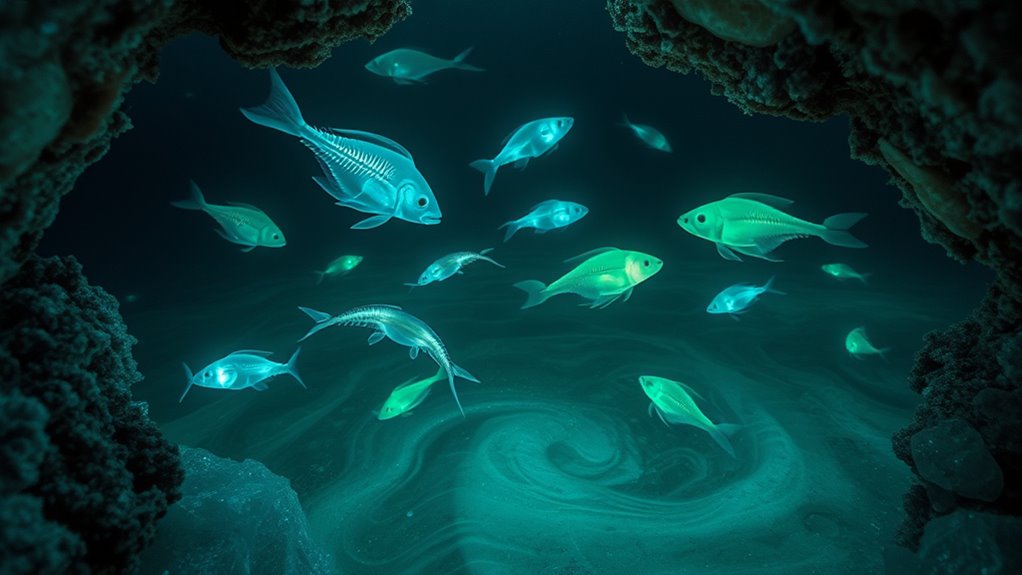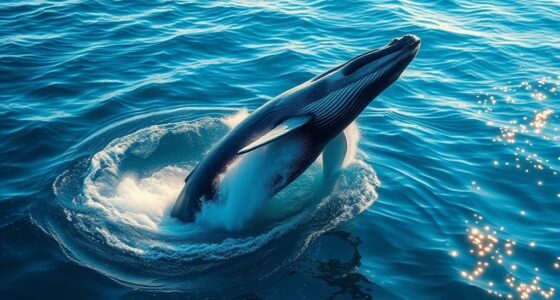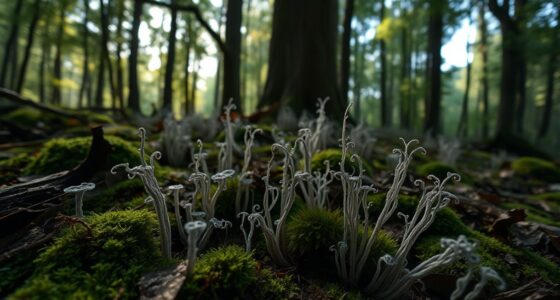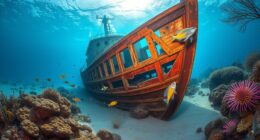In the extreme environment of deep-sea brine pools, you’d find creatures that have developed incredible adaptations to survive. These animals withstand crushing pressures, toxic chemicals, and perpetual darkness by evolving specialized organs, tough shells, and bioluminescent displays. Their glowing signals help attract food, mates, and communicate amid the darkness. If you keep exploring, you’ll uncover the fascinating ways these extraordinary creatures thrive in one of Earth’s most hostile habitats.
Key Takeaways
- Deep-sea brine pool creatures thrive under extreme pressure, high salinity, and darkness, developing unique adaptations to survive.
- They utilize bioluminescence for communication, attracting prey, and deterring predators in the pitch-black environment.
- These animals often have specialized organs called photophores, producing complex light patterns for signaling.
- Their evolutionary adaptations include robust exoskeletons and cellular structures to withstand toxicity and pressure.
- Bioluminescence and other survival traits highlight how life persists and adapts in some of Earth’s most hostile habitats.
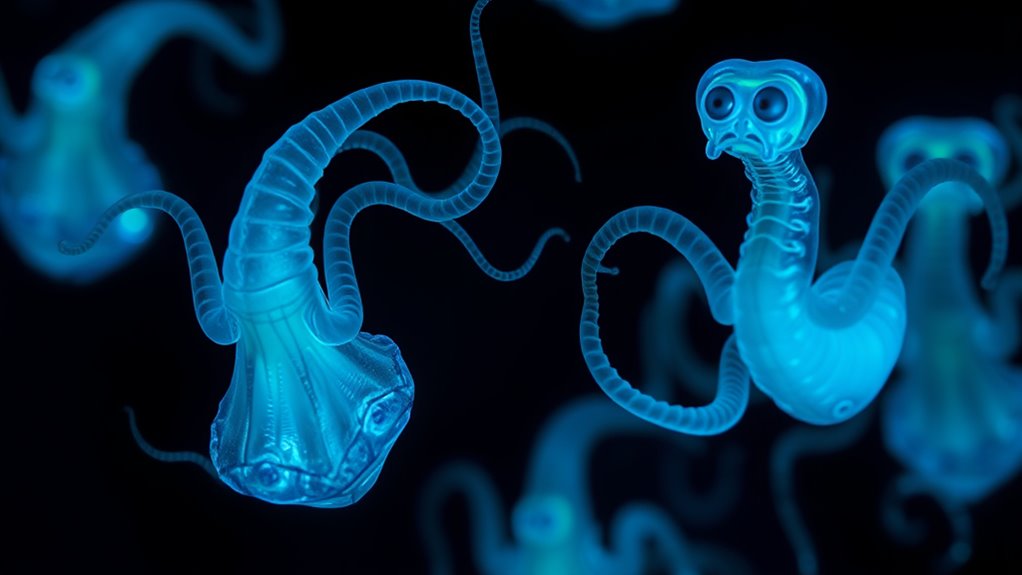
Have you ever wondered what life looks like in the extreme depths of the ocean? Beneath the surface, in the dark, high-pressure environment of deep-sea brine pools, creatures have evolved extraordinary ways to survive. These animals display extreme adaptations that allow them to withstand conditions that would crush or sterilize most life forms elsewhere. The high salinity, chemical toxicity, and absence of sunlight create a challenging habitat, yet life persists through remarkable evolutionary innovations. You’ll find creatures here that have developed specialized organs to handle the intense pressure and chemical makeup, such as robust exoskeletons or unique cell structures that resist damage. Some species even thrive by feeding on the chemical-rich substances that seep into these pools, turning what seems like a hostile environment into a resourceful living space.
A defining feature of many deep-sea brine pool creatures is their bioluminescent behaviors. In the pitch-black environment where sunlight never penetrates, producing their own light becomes essential. This bioluminescence serves multiple purposes: attracting prey, deterring predators, or communicating with others of their kind. For example, some species emit gentle glows from their bodies, creating flickering signals that help them locate mates or find food in the darkness. Others have specialized organs, called photophores, that can produce complex light patterns. These bioluminescent displays are not just beautiful but crucial for survival, functioning as a kind of underwater Morse code. You might imagine how mesmerizing it is to see these creatures flickering in the gloom, their lights piercing the dark ocean depths like stars in a black sky. Additionally, these adaptations demonstrate how extreme environments can foster unique evolutionary solutions, revealing nature’s capacity for innovation even in the most inhospitable settings.
Frequently Asked Questions
How Do Deep-Sea Brine Pool Creatures Communicate?
You might wonder how deep-sea brine pool creatures communicate. They use bioluminescent signaling, emitting light patterns to attract mates or warn predators. Additionally, they rely on chemical communication, releasing specific substances in the water to convey messages or find others nearby. These methods help them survive in the dark, high-pressure environment of the deep sea, where visual cues are limited, and chemical signals become essential.
Can These Creatures Survive Outside Their Extreme Environment?
Ever wondered if deep-sea brine pool creatures can survive outside their extreme environment? They likely can’t, thanks to specialized evolutionary adaptations and limited genetic diversity that make them perfect for their high-pressure, toxic habitats. Moving to less extreme conditions could threaten their survival because their bodies aren’t built to handle different environments. Their unique adaptations are essential for their existence, and they probably wouldn’t thrive elsewhere.
What Is Their Role in the Ocean’s Ecosystem?
You might wonder about their role in the ocean’s ecosystem. These creatures contribute to nutrient cycling and energy transfer, supporting other marine life. Their bioluminescent adaptations help them communicate and attract prey in dark waters. Additionally, their reproductive strategies guarantee species survival in extreme environments. By understanding these roles, you see how they fit into the complex web of ocean life, maintaining ecological balance even in the most extreme conditions.
How Do They Find Food in Such Dark Conditions?
Imagine you’re lost in a pitch-black cave, relying on ancient skills. Deep-sea brine pool creatures find food through bioluminescent signaling, lighting up their surroundings or potential prey. They also use chemical communication to detect nutrients or signals from other organisms. This combination helps them navigate and hunt in the darkness, much like a submarine’s sonar, ensuring they survive in one of Earth’s most extreme environments.
Are Any Brine Pool Creatures Dangerous to Humans?
You might wonder if brine pool creatures pose any danger to humans. While some Brine pool predators, like certain eel species, could be risky if encountered, most deep-sea creatures are harmless due to their extreme environment. Deep sea symbiosis helps these animals survive without hurting humans. Generally, these creatures aren’t dangerous because they rarely come into contact with us, and their adaptations protect them from threats.
Conclusion
Now that you’ve seen how these mysterious creatures thrive in extreme conditions, it’s hard not to wonder—what else is out there, waiting to surprise us? Their secret lives remind you that the deep ocean still holds countless mysteries, just waiting to be uncovered. Are you curious enough to explore further and discover what other incredible adaptations these creatures have? The deep sea’s hidden world might just change what you think is possible.
